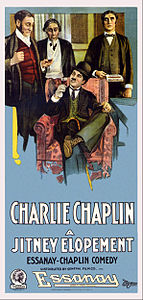Kidnapping (1915)
| Movie | |
|---|---|
| German title | kidnapping |
| Original title | A jitney elopement |
| Country of production | United States |
| original language | English |
| Publishing year | 1915 |
| length | 33 minutes |
| Rod | |
| Director | Charles Chaplin |
| script | Charles Chaplin |
| production | Jess Robbins |
| camera | Harry Ensign |
| occupation | |
| |
Kidnapping a 1915 American silent film by actor and director Charles Chaplin .
action
Edna is a daughter from a good family and accordingly her father wants to marry her off well. So it is very convenient for him that Count Chloride de Lime wants to ask for her hand (albeit out of greed for money). However, Edna is in love with the destitute Charlie and desperate about the impending forced marriage. The lover whom she called to help decides to introduce himself to Edna's father as Count Chloride de Lime. He is also received with open arms and invited to dinner. Despite Charlie's manners, which took a bit of getting used to, the evening took a happy turn until the real Count Chloride de Lime signs up. Charlie's masquerade is exposed and he is expelled from the house. Now the actual count is introduced to Edna. The elegant gentleman invites father and daughter to a trip to the park. With a coin taxi ("Jitney") they set off. Charlie soon appears in the park and the animosities between him and the count break out. After Charlie knocked Edna's father down and the situation was complicated by the police hurrying to help, Charlie and Edna flee in the count's coin taxi. The father, the count and the police are following the couple with a car that was unceremoniously confiscated. A wild chase begins, which ends for the pursuers and their car in the river and leaves the couple happy.
background
The film is one of the earliest in which the tramp shows its romantic side, which was expanded in the follow-up work The Tramp . It is divided into a more leisurely first half, which takes place in Edna's father's house, and a faster second half outside. The second half is again divided into a "park comedy" and a car chase. Charlie kidnaps Edna in a jitney, a coin-operated taxi that was common in the United States between 1914 and 1916. "Jitney" is also an outdated name for a nickel .
In the first part of the film, the film contains a gag that Chaplin had already presented on stage during his time as a theater actor with Fred Karno : at dinner with Edna and her father, he thoughtfully cuts a loaf of bread into an accordion . The highlight of the film is the car chase, which is rather unspectacular compared to other contemporary Sennett films. In a panoramic shot, the cars waltz with each other or drive in a circle, confused by the rotating blades of a windmill. This scene was filmed in San Francisco's Golden Gate Park at the Murphy Windmill. It is also interesting that the clayey road the cars use is what is now the Great Highway.
Web links
- Kidnapping in the Internet Movie Database (English)
- Kidnapping in the online film database
swell
- ↑ David Robinson: Chaplin. His life, his art . Diogenes, Zurich 1993, ISBN 3-257-22571-7 . P. 176
